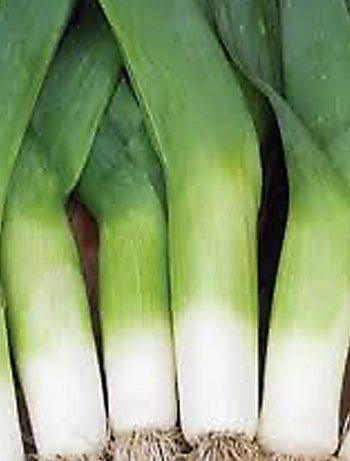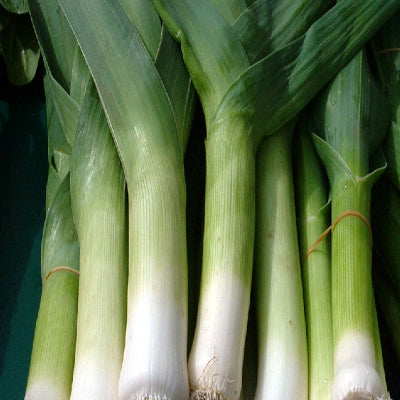How to Grow Leek

The essential guide to growing leek from seed; with notes on germination, cultivation, harvest and even kitchen uses.
- Autumn leeks (e.g. ‘Musselburgh’, ‘Bulgarian Giant’) – thicker shanks with a mellow, sweet-onion flavour; perfect in pies, frittatas and roasted veg trays. These varieties will hold well into winter as well.
- Winter / overwintering leeks (e.g. 'Blue Solaise', 'Durabel') – stocky, blue-green leaves, very frost-hardy; lend rich depth to slow soups, stews and leek-and-potato classics.
- Baby / bunching leeks – most varieties are suitable for baby leeks, just harvest pencil-thin; add delicate onion notes to omelettes, stir-fries and tapas platters.
Seeds per Gram: ≈ 300 – 350 seeds
Germination Temperature: 18 – 23 °C (emergence in 10 – 14 days)
Feed Requirements:
- Heavy feeder.
- Before sowing incorporate 5 cm compost plus a complete organic fertiliser (approx. 100 g m⁻²).
- At transplanting: dust furrow with additional fertiliser.
- Mid-season: side-dress with blood & bone or liquid seaweed to maintain steady growth.
Growing Notes:
Climate & Timing
- Temperate / cool zones: sow late winter–early spring for summer leeks; sow mid-summer for winter harvest.
-
Sub-tropics: sow autumn for winter harvest; avoid humid wet-season.
Leeks relish cool, moist conditions and tolerate light frosts.
Sowing & Transplanting
- Seed trays: sow 5 mm deep, fairly thickly in punnets or 10 – 12 seeds per 10 cm pot. Keep moist. Once seedlings resemble thin grass (8 – 10 weeks), trim tops to 8 cm and gently tease apart and transplant into garden.
- Direct sow: 5 mm deep, 10 cm apart in rows 30-45 cm apart; thin to strongest plants.
- Planting out: dibble holes 10 cm apart; place one seedling in each and water to settle (don’t back-fill). As plants grow, gradually fill holes or hill soil around stems to blanch and lengthen the white shank.
Water & Soil
- Require fertile, free-draining loam (pH 6.2 – 7.0) with reliable moisture.
- Water deeply once top 5 cm soil feels dry.
- Mulch thickly to conserve water and suppress weeds.
Cultural Tips
- Maintain weed-free beds; leeks dislike competition.
- For extra-white stems, add a sleeve of cardboard tube or mulch collar around each plant three weeks before harvest.
Common Problems & Fixes:
- Poor germination: seed older than two-three years loses vigour—use fresh each season.
- Rust (orange pustules): ensure full sun, good airflow and avoid excess nitrogen; remove affected foliage.
- Onion thrips / aphids: hose off or apply insecticidal soap; encourage lacewings and ladybirds.
- Bolting: caused by seedling cold shock or moisture stress—sow/plant after risk of hard frost, keep irrigation even.
Harvesting & Storage:
- Harvest leeks any time stems reach 15+ mm diameter.
- Lift with a garden fork and shake soil away.
- Leave roots on until kitchen prep to keep stems turgid.
- In most regions leeks hold in-ground through winter—pull as required.
- For short storage, wrap cleaned stems in a damp cloth inside a perforated bag; refrigerate up to two weeks.
- Longer term, slice and blanch 2 min, then freeze for soup bases.
Nurture leeks with rich soil, steady water and gentle hilling, and these cool-season stalwarts will reward you with sweet, snowy stems that carry Australian kitchens from summer barbies right through the chilliest stew season.
Sowing Periods
| J | F | M | A | M | J | J | A | S | O | N | D | |
|---|---|---|---|---|---|---|---|---|---|---|---|---|
| Cool | ||||||||||||
| Temperate | ||||||||||||
| Sub-Tropical/Tropical |
Filters
6 products
Leek 'Durabel'
Sale price$3.75
LEEK 'Giant Carentan'
Sale price$3.75
LEEK 'Musselburgh'
Sale price$3.75
Leek ‘American Flag’
Sale price$3.75
LEEK ‘Blue Solaise’
Sale price$3.75
LEEK ‘Bulgarian Giant’
Sale price$3.75






